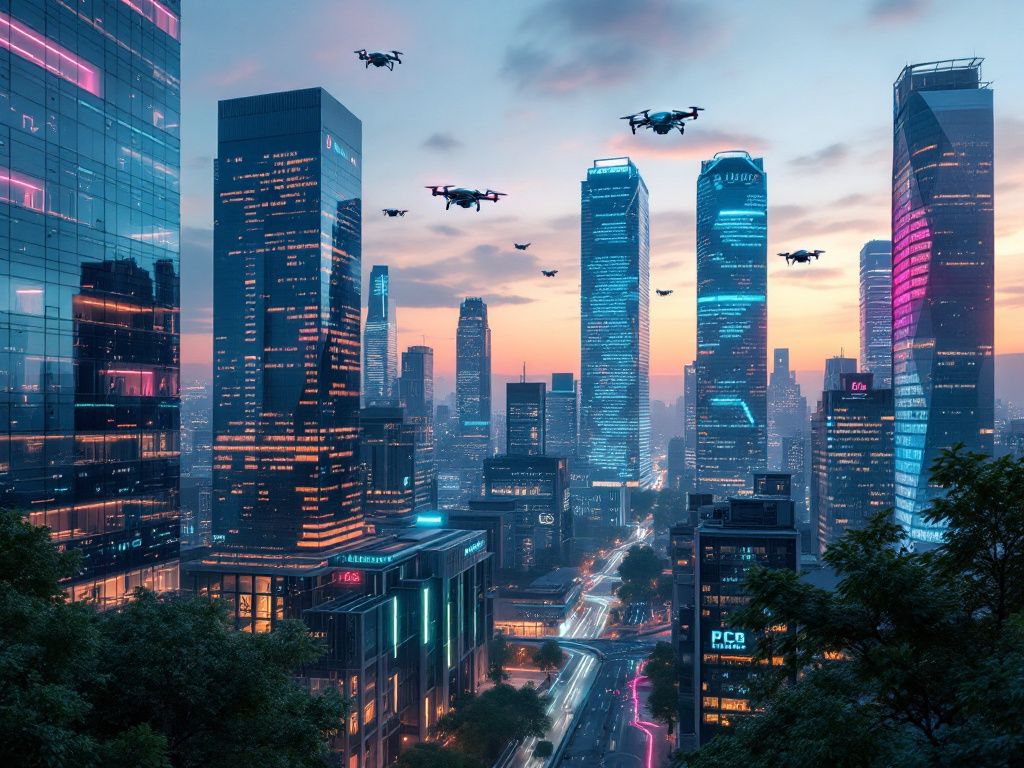Emerging technologies continue to reshape our world at an unprecedented pace, driving innovation across industries and transforming how we live, work, and interact. From artificial intelligence and blockchain to quantum computing and advanced robotics, these breakthrough innovations hold immense potential to revolutionize entire sectors while creating new economic opportunities and societal paradigms.
Good to know
The convergence of multiple emerging technologies is creating synergistic effects that amplify their individual impacts. Quantum computing combined with AI could solve complex problems in minutes that currently take years, while blockchain integration with IoT devices promises unprecedented security and transparency in data management across global networks.
The ever-evolving landscape of emerging technologies
The technological landscape continues to transform at an unprecedented pace, with emerging technologies serving as the primary catalysts for innovation and economic expansion across multiple industries. These revolutionary developments represent more than incremental improvements; they fundamentally reshape how societies function and businesses operate.
Historical Evolution and Defining Characteristics
Emerging technologies are characterized by their radical novelty, relatively fast growth, and potential to exert considerable impact on socio-economic domains. Throughout history, technological breakthroughs have consistently driven economic growth, from the industrial revolution’s steam engines to the digital age’s internet infrastructure. The current technological era distinguishes itself through the convergence of multiple innovations occurring simultaneously, creating exponential rather than linear progress.
The evolution from theoretical research to commercial applications has accelerated dramatically. What once required decades now unfolds within years, as seen with the rapid advancement of artificial intelligence systems. This acceleration stems from improved research methodologies, increased funding, and enhanced collaboration between academic institutions and private enterprises.
Current Technological Frontiers
Artificial intelligence stands as perhaps the most transformative emerging technology of our time. Machine learning algorithms now process vast datasets to identify patterns previously invisible to human analysis, revolutionizing fields from healthcare diagnostics to financial risk assessment. The technology’s impact extends beyond automation, enabling entirely new business models and service delivery mechanisms.
3D printing technology has evolved from prototyping tool to manufacturing solution, enabling customized production at scale. Industries ranging from aerospace to healthcare leverage additive manufacturing to create complex components previously impossible through traditional methods. This technology reduces material waste while enabling distributed manufacturing networks.
Blockchain technology provides secure, transparent transaction frameworks that extend far beyond cryptocurrency applications. Supply chain management, digital identity verification, and smart contracts represent emerging applications that could fundamentally alter how businesses establish trust and execute agreements in digital environments.
Economic Impact and Sector Transformation
These technologies collectively drive economic growth through productivity gains, new market creation, and cost reduction. The convergence of multiple emerging technologies amplifies their individual impacts, creating compound effects that accelerate innovation cycles and market disruption across traditional industry boundaries.

Key players and geographical hotspots in technology innovation
The global innovation ecosystem is dominated by strategic partnerships between leading corporations, dynamic startups, and influential geographic regions that collectively drive technological advancement. This interconnected network of players creates a competitive yet collaborative environment where breakthrough technologies emerge and scale rapidly.
Corporate Giants Leading Innovation
Major technology corporations serve as the backbone of emerging technology development, with Google pioneering artificial intelligence through its DeepMind division and quantum computing initiatives. Microsoft has established itself as a leader in cloud computing and enterprise AI solutions, while Apple continues to revolutionize consumer electronics and augmented reality experiences. SpaceX has fundamentally transformed the aerospace industry through reusable rocket technology and satellite internet infrastructure, demonstrating how private companies can disrupt traditional sectors.
These corporations invest billions of dollars annually in research and development, creating comprehensive ecosystems that span from fundamental research to commercial applications. Their influence extends beyond product development, as they acquire promising startups and establish partnerships with academic institutions worldwide.
Geographic Innovation Hubs
The United States maintains its position as the global leader in technology innovation, with Silicon Valley, New York, and Washington serving as primary centers for venture capital, fintech, and government technology initiatives respectively. China has emerged as a formidable competitor, particularly in artificial intelligence, 5G networks, and electric vehicle technology, supported by substantial government investment and a massive domestic market.
Europe contributes significantly through its focus on sustainable technologies and digital privacy regulations, with London serving as a fintech capital and countries like Germany leading in industrial automation. These regions create distinct innovation cultures that influence global technology trends and regulatory frameworks.

Legal and ethical challenges in emerging technologies
As emerging technologies rapidly advance across global innovation hubs, they bring unprecedented legal challenges and ethical concerns that require immediate attention from policymakers, industry leaders, and society at large. The intersection of technological progress with existing legal frameworks has created complex regulatory gaps that governments and organizations worldwide are scrambling to address.
Data Privacy and Protection in the Digital Age
The exponential growth of data collection through AI systems, IoT devices, and digital platforms has intensified data privacy concerns globally. The European Union’s General Data Protection Regulation (GDPR), implemented in 2018, established a comprehensive framework requiring explicit consent for data processing and imposing substantial fines for violations. Companies like Meta faced penalties exceeding $1.3 billion in 2023 for GDPR violations, demonstrating the financial implications of non-compliance.
In the United States, the California Consumer Privacy Act (CCPA) provides similar protections, while China’s Personal Information Protection Law (PIPL) mirrors these approaches with stricter data localization requirements. These regulatory frameworks require organizations to implement privacy-by-design principles and conduct regular impact assessments before deploying new technologies.
Intellectual Property Rights and Innovation Protection
Emerging technologies have complicated traditional intellectual property concepts, particularly regarding AI-generated content and inventions. The U.S. Patent and Trademark Office has grappled with questions about whether AI systems can be listed as inventors, while courts examine ownership rights for machine learning outputs. Patent applications for AI technologies increased by 34% between 2022 and 2024, creating backlogs and examination challenges.
AI Ethics and Algorithmic Accountability
The deployment of artificial intelligence raises significant AI ethics questions regarding bias, transparency, and accountability. The EU’s AI Act, which became fully applicable in 2024, categorizes AI systems by risk levels and mandates human oversight for high-risk applications. Financial institutions using AI for credit decisions must now provide explanations for automated decisions, while healthcare AI systems require clinical validation before deployment.

Future trends and the path ahead for emerging technologies
The technological landscape continues to evolve at an unprecedented pace, with several key trends poised to reshape industries and society in the coming decade. Understanding these trajectories is essential for organizations and individuals preparing for a fundamentally transformed future.
Quantum Computing’s Commercial Breakthrough
Quantum computing stands at the threshold of practical implementation, with major corporations investing billions in development. By 2030, experts predict quantum systems will achieve quantum advantage in specific applications such as drug discovery, financial modeling, and cryptography. IBM’s roadmap targets 100,000-qubit systems by 2033, while Google’s quantum AI division continues advancing error correction techniques. These developments will revolutionize optimization problems currently intractable for classical computers, particularly in supply chain management and materials science.
IoT Ecosystem Maturation and Edge Intelligence
The Internet of Things is transitioning from connectivity-focused deployments to intelligent, autonomous networks. Current projections indicate over 75 billion connected devices by 2030, with edge computing processing 75% of data locally. Smart cities are implementing comprehensive IoT infrastructures for traffic optimization, energy management, and public safety. Industrial IoT applications are achieving significant ROI through predictive maintenance and real-time quality control, with manufacturing efficiency improvements averaging 20-30%.
Advanced Robotics and Autonomous Systems
Robotics technology is evolving beyond traditional manufacturing applications toward general-purpose systems capable of complex reasoning and adaptation. Collaborative robots are becoming increasingly sophisticated, with AI-driven decision-making enabling autonomous operation in unpredictable environments. Healthcare robotics, particularly surgical and rehabilitation systems, are demonstrating remarkable precision improvements while reducing human error rates by up to 85%.
Neuromorphic Computing Revolution
Neuromorphic computing represents a paradigm shift toward brain-inspired architectures that promise dramatic improvements in energy efficiency and processing speed. Intel’s Loihi and IBM’s TrueNorth chips demonstrate the potential for ultra-low-power AI processing, particularly valuable for mobile and embedded applications.
Technology Convergence and Synergistic Innovation
The most transformative developments emerge from convergence between quantum computing, IoT, and advanced robotics. Quantum-enhanced machine learning algorithms are enabling breakthrough capabilities in pattern recognition and optimization. This convergence is creating entirely new technological categories, such as quantum sensors for IoT networks and neuromorphic processors for autonomous robotics systems, fundamentally altering competitive landscapes across multiple industries.

What to remember from emerging technologies innovation
The landscape of emerging technologies presents both extraordinary opportunities and significant challenges that will define our collective future. As quantum computing, advanced AI, and IoT continue to mature, their convergence promises to unlock unprecedented capabilities across industries. However, success will depend heavily on how effectively we address regulatory frameworks, ethical considerations, and global collaboration. The coming decade will likely witness accelerated adoption rates, with early adopters gaining substantial competitive advantages while societies adapt to rapid technological transformation and workforce evolution.